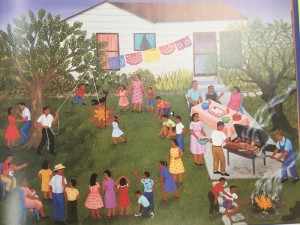Using a multilingual perspective to design small group and individualized instruction
Teaching for Biliteracy encourages teachers to take on a multilingual perspective when working with bilingual students. We seek to understand all a student knows, in all domains and in all languages. We honor approximations. We capitalize on resources. We use these as strengths upon which we can build transfer. This blog entry is an overview of how we can apply a multilingual perspective to designing small group and individualized instruction. I will use a fourth grade student Valeria (who you might remember from Language Development and Literacy Processing post) and Carmen Lomas Garza’s In My Family text as an example.
Step 1: Capture an oral language sample, a reading sample, and a writing sample in one language.
 Valeria’s oral language clip in English
Valeria’s oral language clip in English

Valeria’s reading of Birthday BBQ in English and Valeria’s retelling in English

Step 2: Capture an oral language sample, a reading sample, and a writing sample in another language.

Valeria’s oral language clip in Spanish

Valeria’s reading of Empanadas in Spanish Valeria’s retelling in Spanish

Step 3: Look across domains. How might instruction capitalize on strengths?

Step 4: Look across languages. What strategies or skills might be opportunities to transfer across languages?

Step 5: Plan and deliver targeted teaching.
Based on the above analysis, I developed the following possible learning outcomes for Valeria’s future instruction:
- I can use what I know about phrasing and punctuation in writing to help me with phrasing and punctuation in reading (in Spanish). See clip.
- I can use what I know about monitoring my reading in English to help me with monitoring my reading in Spanish. See clip.
- When I arrive at a difficult word in English, I can write the word and reread the sentence to help myself. See clip.
- In writing, (both languages), I can reread my writing to make sure it sounds right.
A holistic analysis sets us up to understand the whole child. A monolingual perspective in which observation and teaching happen only in one language might prevent us from accessing important resources that the child possesses. Our teaching is most effective when we begin with what the child knows, and teach for transfer across domains and across languages.
Readers, how have you carried out a multilingual perspective in designing small group or individualized instruction?

